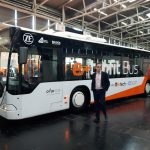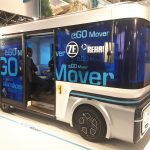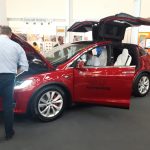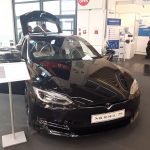
This week I had the chance to visit the trade fair eMove360° Europe. The fair’s topic was ‘Mobility 4.0: electric – connected – autonomous’. It was very interesting to see so many different innovations around e-mobility. I had several good conversations with industry experts at the fair. Coming back to the fair’s topic, I thought ‘electric’ very dominant. From an IT perspective the ‘connected’-part came short and was not innovative. The ‘autonomous’-part was hardly present. It seems to me, that there is still a way to go. I also missed a part about producing clean energy, because in my opinion there is no zero-emission vehicle as long as the energy still comes from traditional power plants.
Industry Experts
Last Mile Mobility
One topic I did not have on my radar is ‘last mile mobility’. This topic is particularly relevant in cities, where people use public transport to commute. As public transport usually stops in dedicated places, there is still a distance to the final destination (e.g. office). This final distance is called the ‘last mile’. Obviously, one could walk this last mile or use a bicycle. This might take longer or even be exhausting. This is where last mile solutions come in. A very well-known last mile mobility possibility is Segway. However, it is very difficult to commute with a Segway. Additionally, there usually are no Segways at a random metro station. Thus, there is a need for smaller, easy-to-carry solutions, that can help us covering that last mile.
Covering the Last Mile with UrmO
This is where UrmO – a Munich based startup – came up with a solution. They offer a product with the same name. To me the UrmO looks like a light-weight Segway without a steering bar. I liked the folding concept. In a live demo the UrmO was folded within seconds. Once folded together it is easy-to-carry around (e.g. in a metro). During the live demo the UrmO appeared easier to navigate than some of the existing Unicycle / Solowheel solutions (e.g. Ninebot, InMotion). The two wheels gave it more stability. It will be interesting to see how the UrmO compares to the other mentioned solutions in terms of price and durability.
Extending the lifetime of old Diesel Buses with e-trofit
In-tech, a company based in Garching near Munich, presented a 15-year-old diesel bus, which they transformed into a modern, fully electric bus. The interesting point was not the electric bus itself. I was already aware of some electric busses, especially by the big players. No, what in-tech did, was take the old bus, remove the entire diesel engine including its components and integrate a new electric engine, including power unit, batteries, air condition and so on. The bus was shown in real life. It is supposed to go on duty in Landshut next year. I am interested whether the concept of (r)etrofitting old diesel busses works out. With half the invest compared to acquiring a new bus, all theory looks positive.
e.GO Mover – a Bus Concept to extend Public Transport
Checking out the fair’s exhibitor list one company caught my interest – e.GO Moove. I read about their small bus concept e.GO Mover a couple of months ago. Thus, this was my chance to check it out. Honestly, I was a bit disappointed when I saw the e.GO Mover with a fully functioning driver’s cabin. I knew the e.GO Mover is planned as a level 5 autonomous driving vehicle. There is a standardized classification for autonomous driving. Level 5 is the highest degree of autonomous driving with no driver and no steering wheel required anymore. Maybe my expectations were simply too high. The e.GO Mover is still a good idea and will find its place. However, I believe the e.GO Mover driving at level 5 can be a giant step forward for public transport especially on less popular routes, which currently are economically not feasible or subsidized.
Rytle – One future of Package Delivery
I am cycling a lot to get around. In the city, especially during rush hours, bicycles are often faster than cars. The company Rytle wants to use this. They offer an interesting solution for e-bike based package delivery system. With online shopping growing by the day, the need for package delivery is ever-growing. The problem for parcel deliverers is not only the crowded streets with traffic jams, but also the lack of suitable parking spots. Rytle developed a cargo e-bike with standardized boxes. In contrast to other cargo e-bike solutions the Rytle box can be exchanged semi-automatically within minutes. What I liked is the end-to-end solution. The so-called box-in-a-box-in-a-box idea.
The Box in a Box in a Box
Each cargo e-bike can carry one box that contains a lot of packages. A couple of such boxes fit into a larger box which can be carried by a truck, for example from the distribution center outside the city to a small distribution point in the city. From there the e-bike drivers can pick up one box after the other. The small boxes can be filled with packages at the large distribution center upfront. There is no need for re-arranging later. Using cargo e-bikes enables the drivers to use cycle lanes and sidewalks. Thus, they are often faster than cars and additionally, can stop directly in front of the house without having to look for a suitable parking spot.
Charging Stations – the Fuel Pump of the Future
Many of the exhibitors were companies that provide charging stations. Frankly, I was confused, because there were just so many different companies and it looked like they all offer somehow the same, but in a different design. Fortunately, the industry expert Pedro Domingues from EFACEC Electric Mobility explained several technical details to me. I already heard of fast-charging and slow-charging. Simply put: fast-charging is more expensive, but useful for instance on highways, when people want to continue their journey soon. Slow-charging is less costly and useful for instance in carparks, when people stay for some time. I was not aware of all the different types of plugs. From what I learnt there are currently four to five different plug systems available, depending on the region where the car is from (North America, Europe, Japan, China, Tesla (!)). This shows, there is still some development and standardization required.
Required Adjustments in Infrastructure
Pedro Domingues also pointed out, that there is still a way to go until all petrol stations are equipped with enough power. According to him, most petrol stations are designed to supply enough power to run the petrol station itself, but not to additionally provide energy to electric vehicles. I was very surprised by this, because I, naively, thought it would be easy to simply turn existing petrol stations into future power stations for electric vehicles. An attached battery park could be one solution. Following up I chatted with several battery providers. However, being absolutely no expert in this area, I did not feel like there is a huge step forward in battery technology.
Connectivity – what’s new?
Most of the exhibitors showed some connectivity solutions. However, to me there was nothing really new. With today’s possibilities I expect, that I can see the status of my charging systems, my vehicles or batteries in a mobile app. I think, this is standard and does not need to be mentioned anymore. Also, collecting data from my charging systems, aggregating them and visualizing them in real-time is nothing new and something I expect. The next marketing topics were payment and fleet management solutions. Such solutions already exist and I have not seen anything that did not exist before. I would like to have the possibility of integrating existing solutions. Solutions, which I might use already. In the end, there was a lot of marketing hype. Maybe it is, because I am from IT, but none of these connectivity topics impressed me.
Where does the power come from?
E-mobility is definitely a big topic for the near future. Therefore, it was extremely beneficial for me to get an update from industry experts. It became clear, that we are still in the beginning of that change. There is a way to go – especially when it comes to bureaucracy and infrastructure. One topic I missed completely was how we generate all this energy. In my opinion this topic almost always gets swept under the carpet. It sounds good to have zero-emission vehicles driving around. However, as long as the energy for the zero-emission vehicles still comes from power plants that are not zero-emission, where is the benefit?










